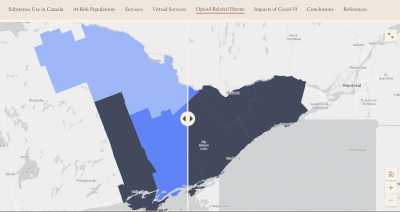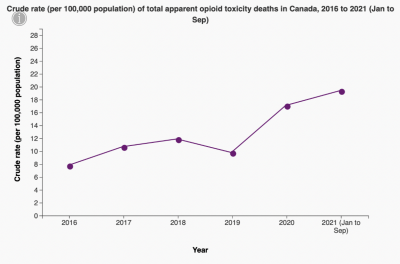ArcGIS StoryMap | Substance Use and Addictions in Rural Eastern Ontario
A National Epidemic with Severe Local Implications: A Global to Local Review of Substance Use to Analyze the State of Addictions in Rural Eastern Ontario

A National Epidemic with Severe Local Implications

This research (summarized below) is also presented as an interactive ArcGIS Storymap available at the following link.https://storymaps.arcgis.com/stories/bb20d5648bd54e778b27e16a603b2d47.
Substance Use in Canada
The dramatic rise in substance-use disorder prevalence across North America has become an urgent and escalating health issue in need of rapid intervention. In 2012, Statistics Canada conducted a study concluding that 6 million Canadians met the criteria for substance-use disorder, but even this value is thought to be an underestimate (1). It is likely this statistic has increased greatly since 2012 when considering the surging overdose crisis and significant increase in opioid-use, as well as opioid-related deaths in the past three years (2). In 2017, the cost of substance use was calculated to be $46 billion, a 5.4% increase since 2015, which factored for associated healthcare, lost productivity, criminal justice, and other direct costs (3). Substance use and addictions in Canada is therefore multifactorial, involving social, health, and economic implications.

Substance use and addiction is a global public health crisis that has rapidly escalated over the last decade. Substance use disorder is one of the most prevalent causes of morbidity and mortality internationally (4), with alcohol- and opioid-related harms being of most concern. The United States of America and Canada have historically had the highest prevalence of opioid drug use mostly due to the availability of such drugs when compared to less developed countries and have both seen an even greater increase in use since the emergence of Covid-19. Of greatest concern, is the spike in opioid deaths which has also more than doubled since 2010 (5). Canada and the United States have the highest rates of prescribed opioids worldwide, and although the US sees considerably more opioid-related deaths, per capita opioid use, and alcohol-attributed health deficits, recent data shows Canada is paralleling increases in these areas which is a cause of great concern (6). Continuing health professions education programs have begun to gain a hold on prescription opioids and their potentially harmful effects, but there has been a major increase in non-pharmaceutical opioid use across Canada which accounted for 90% of apparent opioid deaths from January to June 2021 (7).
The life expectancy of Canada has levelled for the first time since World War II, with one of the main contributors being opioid-related deaths. This negative trend was first observed in British Columbia, which has been in a declared public health emergency since 2016 due to significant opioid-related deaths, but life expectancy has since begun to plateau for all of Canada. Most deaths seen in the past five years have been males between the ages of 20-49, which therefore has a significant impact on life expectancy, with alcohol and drug use identified as the most important risk factor among young adults (7).
Alcohol and opioid use are currently a major focus for substance use disorder harms, as these sectors have seen the greatest increase in associated harms and affect the most individuals, although it should be noted that an increase in stimulant use as well as polysubstance use has been observed in the past few years. Substantially less mortality is seen with these substances, and toxic supply is less of a concern, but many of the initiatives and treatment options addressing the opioid crisis can also benefit those impacted by stimulant addiction and polysubstance use. Other addiction disorders such as gambling can also have detrimental effects on overall health and wellbeing of Canadians, but this report will have a greater focus on drug addiction and substance use disorder, specifically regarding opioid use, as it is an incredibly urgent public health crisis causing the death of thousands and therefore requires immediate intervention.
Our interactive ArcGIS Storymap provides further analysis of this epidemic for rural Eastern Ontario, highlighting both the harms and the services available in this region.
Link to the complete Storymap: https://storymaps.arcgis.com/stories/bb20d5648bd54e778b27e16a603b2d47.